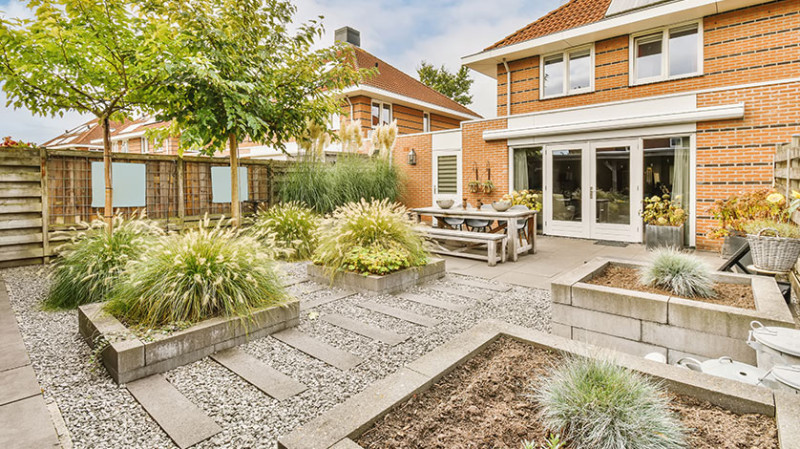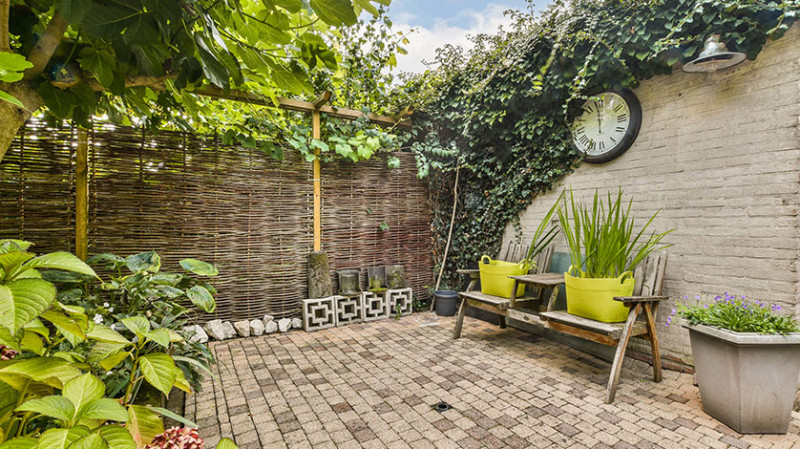
Transforming a sloped garden or hillside into a beautifully landscaped space doesn’t have to cost a fortune. With some creativity, know-how, and a bit of elbow grease, you can make your incline both functional and visually stunning. Whether you’re a DIY enthusiast, a young homeowner looking to add value, or a professional in architecture or landscaping, this guide is full of practical, budget-friendly ideas to suit your needs in the UK.
Here are 27 of the best hillside landscaping ideas on a budget that will not only enhance your outdoor space but also improve drainage, increase usability and boost curb appeal.
1. Tiered Retaining Walls Using Railway Sleepers
Creating tiers is one of the most effective ways to manage a sloped garden. Using reclaimed railway sleepers is a budget-friendly and sustainable option, popular across the UK due to their rustic look and durability.
Install them horizontally to build strong retaining walls that help control erosion and create level planting areas. You can source sleepers from local salvage yards or online marketplaces at a much lower cost than new brick or stone materials.
Combine tiers with gravel or bark mulch paths between levels for easy access and natural style. Given the modular nature of timber sleepers, they're great for DIY projects, allowing homeowners to build and adjust over time.
2. Add Steps with Gravel and Timber
Creating garden steps allows safe and easy access up and down a hill. One cost-effective solution is combining treated wood timbers with compacted gravel. This method is not only economical but blends naturally into rustic or cottage-style gardens.
The wood risers frame each step, holding the gravel in place. It's a method endorsed by many UK garden designers due to its balance of affordability and functionality. Ensure you use weed suppressant fabric beneath the gravel to minimise maintenance.
For safety and stability, keep the rise and run of each step consistent – ideally a 15cm rise and 30-35cm tread length works well. Adding solar stake lights along edges can also improve nighttime usability without increasing energy bills.
3. Plant Ground Covers for Slope Stabilisation
Instead of constantly battling erosion, make nature work for you by planting ground covers that root deeply and stabilise the soil. These low-maintenance plants help keep the hillside intact while reducing your need to mow difficult angles.
Excellent low-budget options in the UK include creeping thyme, vinca minor, sedum, and ajuga. These are generally hardy to the British climate, attract pollinators, and require little water once established.
Not only are they practical, but these foliage layers provide year-round texture and colour to your garden. Try mixing different varieties to create a patchwork effect while ensuring coverage over time.
4. Recycled Brick Pathways
Old materials can make charming new features. If you’ve got access to used bricks (perhaps from left-over building projects), consider laying them into a curved path up or across your hillside. This DIY idea adds character and prevents soil compaction in high traffic areas.
Use a compacted sand base and space the bricks slightly for a rustic feel. This method is popular in period properties throughout the UK, blending beautifully with traditional architecture.
Paths don’t have to be perfectly level on hillsides – gentle meandering slopes are more interesting visually and help manage rainfall runoff effectively.
5. Use Mulch and Bark to Prevent Erosion
Mulching is a cheap and efficient way to control erosion on hills while improving soil fertility. Bark chips, leaf mulch, or composted wood are all widely available at garden centres or in bulk deliveries.
Cover bare soil between plants or around young shrubs to protect roots from water and wind damage. Not only do mulches help retain soil moisture, but they also suppress weed growth, saving you time on upkeep.
For an extra budget tip – check with local tree surgeons or councils in your area. Many give away woodchips for free or at a very low cost.
6. Build a Budget-Friendly Rock Garden
If your slope struggles with heavy rainfall or poor drainage, a rock garden is an ideal solution. Rocks help slow down water runoff, and when combined with drought-tolerant plants like lavender, sedum, and ornamental grasses, they require little upkeep.
You can often source stones for free from local excavation or builders' waste sites, or you can use demolished concrete chunks for a 'urban rustic' take on the rock garden. Lay them into terraces or scatter naturally across the hill, anchoring with planting pockets.
This type of garden not only saves money on water and maintenance, but also provides a peaceful, minimalist aesthetic suitable for modern and traditional UK homes alike.
7. Introduce Rain Gardens or Swales
Rain gardens or swales collect and manage runoff water, which can be a big problem on sloped plots. Installing one can reduce flooding risk around your home and nourish the plants planted in the basin.
Essentially, carve a shallow ditch horizontally along the slope and plant within it using moisture-loving perennials. Iris, arum lily, and hostas are great choices for UK gardens.
Line the base with stones to avoid water erosion, and layer mulch to further retain soil. Not only are rain gardens eco-friendly, but they also create a visually appealing transition between hillside levels.
8. Create Living Walls or Vertical Gardens
On small or steep areas where horizontal planting isn’t practical, vertical gardens offer a clever way to green-up your space without much cost. DIY options include using wooden pallets, hanging shoe organisers, or gutter planters mounted onto fences or surfaces.
Fill these vertical containers with herbs, alpine plants, or trailing annuals for a vibrant layered look. It’s a great project for DIYers and an excellent way to add character to a bare retaining wall without spending on luxury cladding or stonework.
Vertical gardens also work wonders in tighter urban gardens common around London, Bristol, and Manchester, where turf space may be scarce but vertical sunshine is ample.
9. Incorporate Mirror Accents and Artistic Touches
For a bit of quirky charm, consider scattering recycled or upcycled décor into strategic hillside niches. Old mirrors, mosaic tiles, or hand-painted tiles make fantastic focal points when mounted into retaining walls or fences on a slope.
This brings a whimsical personality to your garden and can reflect sunlight onto shady areas. Salvage markets or vintage fairs are good hunts for these treasures, many of which can be had for just a few pounds.
Combining functionality with artistic expression is an easy way to shift an overlooked slope into a curated outdoor gallery space.
10. Wildflower Terraces
Terracing doesn’t have to mean straight grass or veg beds. Try a low-maintenance and ecologically sound approach by seeding tiered beds with UK-native wildflowers like oxeye daisy, red campion, and poppies.
Wildflower turf or seed packets are easy to find locally and create rich biodiversity quickly with minimal irrigation. Their deep roots naturally hold the slope, and they add bursts of colour from spring through to autumn.
This solution is especially suited to rural properties, cottage gardens, or homeowners wanting to encourage butterfly and bee visits without breaking the bank.
Budget Ideas Summary Table
| Idea | Estimated Cost Range (GBP) | Main Benefit |
|---|---|---|
| Railway sleeper tiers | £60 – £150 | Durable and rustic retaining walls |
| Gravel and timber steps | £40 – £100 | Safe hillside access |
| Ground cover planting | £10 – £60 | Reduces erosion and maintenance |
| Recycled brick paths | Free – £50 | Characterful, eco-friendly access |
| Bark mulch erosion control | £15 – £40 | Moisture retention, weed suppression |
| DIY rock garden | £0 – £100 | Drought-tolerant and artistic |
| Rain garden/swale | £30 – £120 | Water management and habitat |
| Vertical garden walls | £10 – £70 | Maximises small or steep spaces |
| Wildflower terraces | £20 – £80 | Pollinator-friendly and scenic |
Final Thoughts
Landscaping a hillside doesn’t require heavy machinery or a large landscape contractor’s bill. With thoughtful planning and time-staggered improvements, even a challenging slope can become a striking feature in your garden that adds real long-term value.
Whether you’re hoping to create an intimate terrace, boost your property’s kerb appeal, or just cultivate a more environmentally conscious outdoor space, these ideas cater to DIYers, professionals, and design enthusiasts alike across the UK.
Start small, reuse where possible, and let the shape of the land guide your design decisions. Hillsides are an opportunity—not an obstacle.






